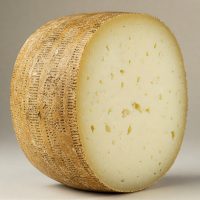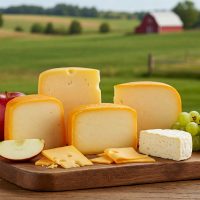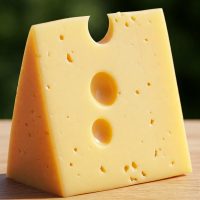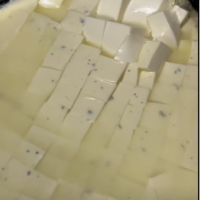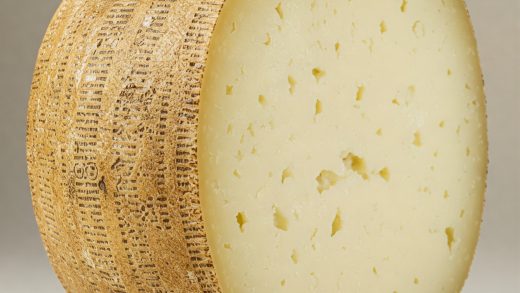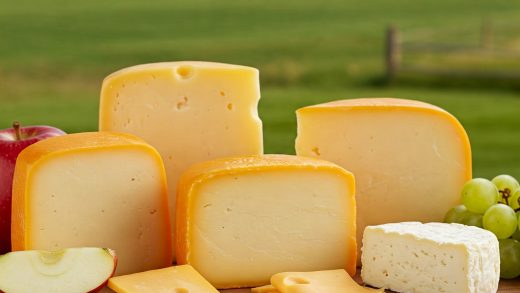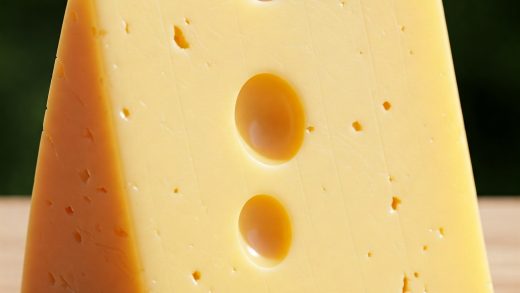For grating hard cheese, you’ll find a microplane grater is often your best bet. Its sharp, fine blades create those light, fluffy shavings that melt easily.
Imagine sprinkling flavorful Parmesan or Pecorino Romano onto your favorite pasta dish – yum! To get those lovely little bits of cheese, you need a good cheese grater.
These cheeses are pretty firm, like a block of tasty treasure, and trying to shave them with a dull or flimsy grater can be a real workout. You might end up with uneven chunks or even hurt your hand.
That’s where the right grater comes in handy. It’s like having a special tool that makes the job super easy. Instead of wrestling with the cheese, you can smoothly glide it across the grater and get those perfect, fluffy shreds.
There are different kinds of graters out there, some that look like a box with holes and others that are long and flat. Knowing which one works best for these harder cheeses can make all the difference in the kitchen, turning a chore into a breeze.
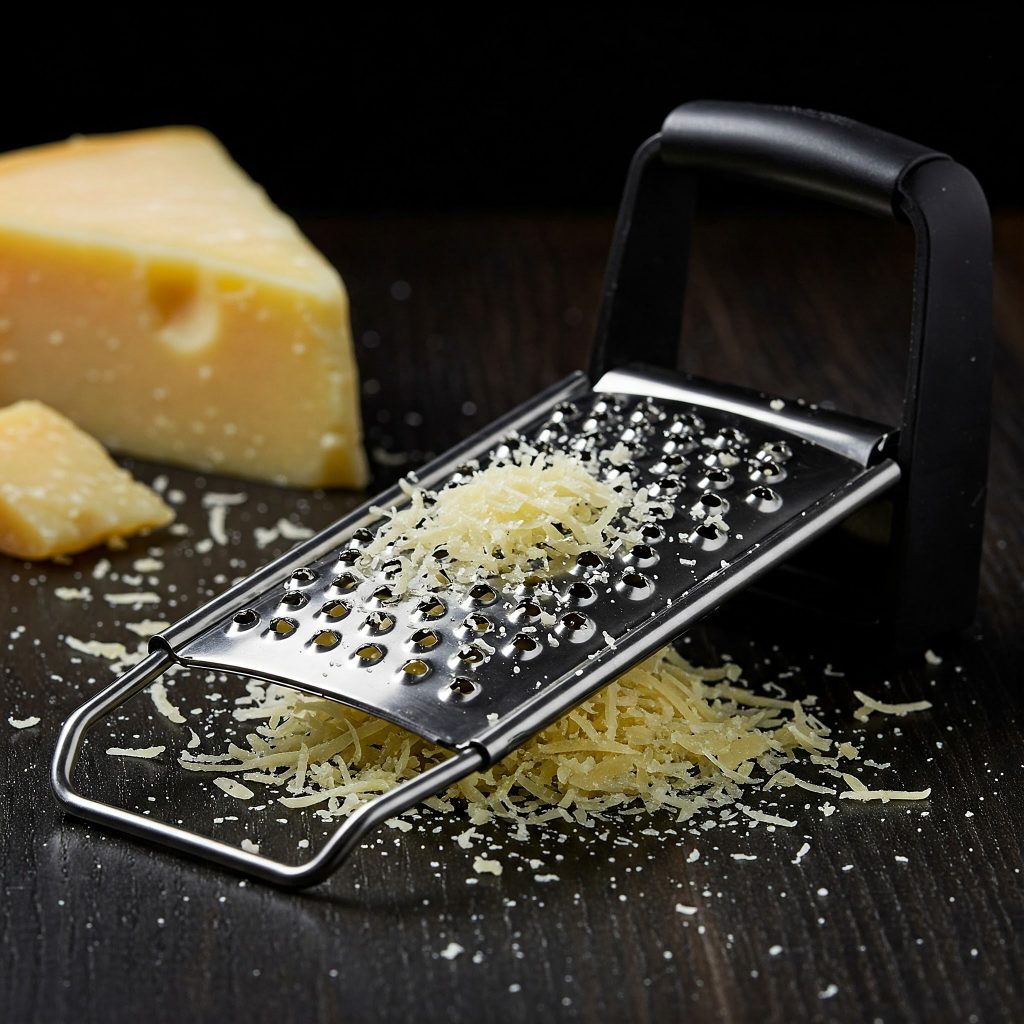
What Makes Hard Cheese Hard?
A “hard cheese” is like the superheroes of the cheese world – they’re strong and last a long time! Think of Parmesan, Pecorino Romano, and Grana Padano.
What makes them tough to grate is that they don’t have much water inside, and they’re packed together super tightly. It’s like trying to grate a really firm apple, but even harder!
Now, you might be thinking, “Why not just buy the cheese already grated?” Well, freshly grated hard cheese is way better! It tastes bolder and has a much nicer texture.
Imagine the difference between biting into a fresh apple slice versus one that’s been sitting out for a while. It’s kind of like that with cheese.
Plus, when cheese is pre-shredded, they sometimes add stuff to it to keep it from clumping, and that can change the taste and how it melts. Freshly grated cheese is pure cheesy goodness!
What are Different Types of Cheese Graters for Hard Cheese?
So you know why grating your own hard cheese is awesome. Now, let’s check out the cool tools that can help you do it.
There are a few different kinds of cheese graters, and some are better than others for those firm cheeses.
Microplane Grater
Imagine a long, skinny grater with tiny, super sharp blades. That’s a microplane.
Why it’s great for hard cheese? These little blades work like magic, shaving off light and airy pieces of cheese that melt super easily into your food.
Bonus! You can also use it to grate things like lemon and orange peels (that’s called zesting) and even spices like nutmeg. Talk about a handy tool.
Good ones to look for
Some popular brands are Microplane (yep, the same name!) and OXO.
Rotary Grater
This one’s pretty neat! You put a chunk of cheese inside, and then you turn a handle, and out come the grated bits.
Easy peasy: It’s really easy to use, especially when you want to sprinkle cheese right at the table.
Different types: You can get small handheld ones or bigger ones that sit on the counter.
Good ones to look for: Check out brands like Zyliss or Cuisinart for rotary graters that work well with hard cheeses.
Box Grater
You’ve probably seen these – they look like a box with holes on all sides.
Which side to use? For hard cheese, the sides with the smaller or medium-sized holes work best.
Important stuff: You want one that feels sturdy and has sharp holes so it’s not too hard to grate.
Good ones to look for: Think about box graters from brands like OXO or KitchenAid that have a non-slippery bottom and a comfy handle.
Electric Grater
These are like the superheroes of cheese grating! They do all the work for you.
Super speedy: If you need to grate a lot of cheese quickly, these are your best friend.
Pick the right one: Just make sure you get one that’s made for hard cheeses, so it can handle the job.
Good ones to look for: Brands like Waring or Presto make electric graters that can tackle hard cheeses.
Factors to Consider When Choosing a Cheese Grater for Hard Cheese
Choosing the right cheese grater for hard cheese involves considering several factors to ensure efficiency, ease of use, and the desired texture. Here are some key aspects to think about:
Type of Grater
Microplane/Rasp Graters: Excellent for creating fine, airy shavings of hard cheese like Parmesan. They are also ideal for zesting citrus and grating spices.
Rotary Graters: Designed specifically for hard cheeses. They offer a safe and efficient way to grate cheese with minimal effort. Some models come with different drums for various textures.
Box Graters: Versatile graters with multiple sides offering different grating options (fine, coarse, slicing). While they can be used for hard cheese, ensure the cheese is cold to prevent it from getting stuck.
Flat Graters: Simple and easy to store, but might require more effort for hard cheeses.
Blade Sharpness and Material
Sharpness: Crucial for grating hard cheese efficiently without excessive force. Look for graters with chemically etched blades, which tend to be sharper than stamped ones.
Material: Stainless steel is the best option due to its durability, rust resistance, and ability to maintain sharpness.
Grate Size
Consider the intended use of the grated cheese. For topping pasta or salads, fine graters are ideal. For dishes where you want the cheese to melt visibly, coarser graters might be better.
Ease of Use and Comfort
Handle: Look for an ergonomic handle that provides a comfortable and secure grip.
Stability: Features like rubber feet or a wide base can prevent the grater from slipping during use.
Ease of Cleaning
Choose a grater that is easy to clean, either by hand or dishwasher safe. Consider models with detachable parts for easier cleaning.
Safety
Some graters come with safety guards or protective covers to prevent injuries.
Storage Space
Consider the size and shape of the grater and how easily it can be stored in your kitchen.
Specific Recommendations for Hard Cheese
Microplane graters are often favored by chefs and home cooks for grating Parmesan and other hard cheeses into fine, delicate shreds.
Rotary graters are also highly recommended for hard cheeses due to their efficiency and ease of use.
Tips for Grating Hard Cheese Effectively
Now, you’ve got your awesome cheese grater. Now, let’s learn some tricks to make grating those hard cheeses like a pro!
Keep it cool
Before you start grating, pop the cheese in the fridge for a little while. When it’s nice and cold, it gets firmer and much easier to grate.
Be steady and even
When you’re grating, press down firmly and move the cheese smoothly across the blades. Don’t push too hard all at once, just use steady pressure.
Try an angle
Holding the cheese at a bit of an angle as you grate can sometimes give you better results. Experiment and see what works best for your grater.
Clean up right away
Don’t let the leftover cheese dry out on your grater. Rinse it off with warm water as soon as you’re done. It’s way easier to clean when the cheese is still soft.
Brush it off
If you do get some cheese stuck in the holes, a little kitchen brush can be super helpful for getting it out.
Need a lot? Think big
If you’re making a dish that needs a whole bunch of grated cheese, you might want to try using a food processor with a grating attachment. It can save you a lot of time and effort!
Conclusion
So, as you can see, picking the right cheese grater makes a big difference when you’re working with those tasty hard cheeses like Parmesan.
Whether you go for the super-fine shavings from a microplane, the easy turning of a rotary grater, the classic box grater, or the speed of an electric one, the best choice really depends on what you need and like.
Think about how much cheese you usually grate, how easy it is to clean, and how much space you have. No matter which one you pick, having a good grater will make adding fresh, flavorful cheese to your meals a breeze.
Now, we want to know what you think! What’s your favorite cheese grater for tackling those hard cheeses? Share your go-to grater in the comments below – we’d love to hear about it.



